BY JERRY SMITH JR.
There is a growing trend today that has many fire departments’ truck companies arriving first at a residential dwelling fire and beginning operations without the protection of a hoseline. The reason may be an increase in call volume brought about by budget cuts; permanent company closures and daily brownouts; or the delayed arrival of the first-due engine, which may be on another call. This article discusses tactics for truck companies operating at dwelling fires without the initial support of an engine company (photo 1).
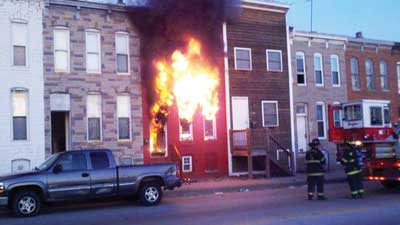 |
| (1) The arrival of a truck company prior to the engine company; notice two firefighters immediately assemble to the rear of the apparatus to begin throwing portable ladders. (Photo by Ian Horowitz.) |
The primary duties of a first-arriving truck company at a residential dwelling fire without an engine on scene should include the following (photo 2):
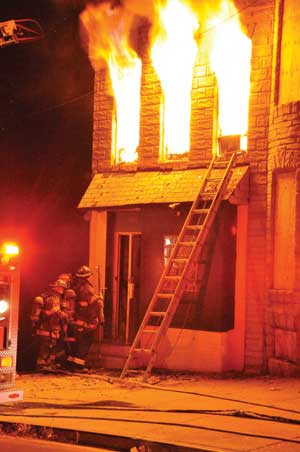 |
| (2) Firefighters complete forcible entry, place a portable ladder, and prepare to make entry to conduct an interior search. (Photo by Nick Eid.) |
1. Conducting a size-up of the situation, including a “Go vs. No Go” assessment to begin interior operations without an engine company on scene.
2. Forcing entry to create access for interior operations and the engine company’s advancing hoseline.
3. Conducting a primary search for victims and the location of the fire.
4. Raising ladders for rescue and upper-floor access and egress.
5. Controlling and conducting vertical and horizontal ventilation.
Under normal conditions, these tactics result in a successful coordinated attack on the fire by both the engine and the truck company (photo 3). However, the delay of an engine company’s arrival necessitates a change in tactics to prevent fire conditions from worsening or becoming untenable for firefighters and victims in the fire building.
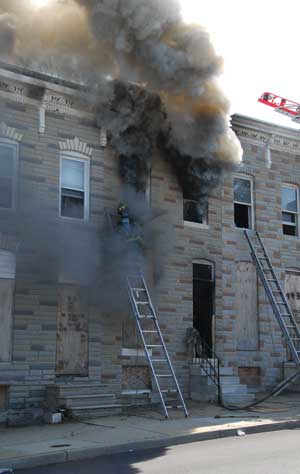 |
| (3) The coordinated attack on the fire: a charged hoseline advancing on the fire with properly timed ventilation. (Photo by Howard Meile III.) |
TACTICAL SAFETY
The mission of the first-arriving truck company is to complete its duties safely and efficiently. These efforts are compounded by the difficulty and danger of operating without the support of an engine company. Therefore, the company officer of the first-arriving truck company will face difficult operational challenges and must perform a complete and thorough size-up and weigh the risks vs. the rewards when faced with the difficult decision of committing the truck company to perform aggressive tactics when there will be a significant delay in getting a hoseline into operation. In addition, the officer will face the following challenges:
- Overcommitting firefighters. The company officer must make decisions that will maximize the effectiveness of his firefighters but temper the increasing stress level and demand that all the primary duties of the first-arriving truck be completed. The impact on the firefighters could lead to poor decision making, an increased risk of injury, and a threat to their overall safety.
- Having firefighters work alone. The firefighters may have to spend an inordinate amount of time out of direct supervisory control; however, the need to provide immediate coverage of critical areas within the fire building-that is, the fire floor, the floor above, and the roof-may call for such measures.
Although good practice dictates that all members work in teams of two, the reality in today’s fire environment is that this is not always possible.
FORCIBLE ENTRY
In the traditional sense, forcible entry is performed by two firefighters operating the irons (ax and halligan). However, when a truck company is forced to operate alone (without the support of the engine company), firefighters may have to split up so they can complete the primary duties of a first-arriving truck company in a more expedient manner. This could mean firefighters will be forcing entry by themselves. The firefighter’s ability to defeat the door increases with sound knowledge of tactical operations while operating alone, such as using the “baseball swing” and burying the point of the halligan in the door’s frame and pushing the tool into the door to force entry. Also, the firefighters must be experienced in using hand tools; hydraulic forcible entry tools; door construction; and managing multiple tools at once, such as using the halligan bar in combination with a striking tool or a steel hook. Remember, hydraulic forcible entry tools can speed up the forcible entry operation and get you inside more quickly, which means you must maintain your own personal safety in relation to the time the hoseline arrives at your location.
 |
| 4) The arrival of the truck company: Four firefighters dismount and ready themselves for truck work. The limited staffing brings attention to how the company can work effectively but balance the risk of working separately from the company officer. (Photo by Nick Eid.) |
Once the door has been forced, controlling the door becomes the critical priority. If fire conditions are present, keeping the door closed will help contain the fire and prevent rapid fire spread. The door should remain closed until a charged hoseline has been stretched. Otherwise, conditions permitting, the firefighter should enter the dwelling and immediately begin a search for life and the fire. While searching, inform the officer of the areas searched and of your whereabouts. Resist the urge to perform unnecessary ventilation because a water source is still not on scene (photos 5, 6).
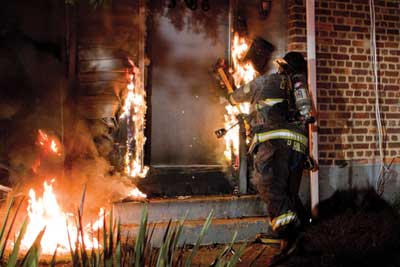 |
| (5) It’s realistic that one firefighter is conducting forcible entry operations alone; notice this firefighter is using a heavy striking tool as a substitute for not having a second firefighter to assist with conventional forcible entry. (Photo by Dave Hernandez.) |
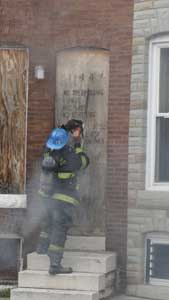 |
| (6) Expect to encounter additional security devices on first-floor doors and windows; at this fire, the chain saw is required to first remove the outer plywood covering the doorway before the inward opening door can be forced. (Photo by Nick Eid.) |
PRIMARY SEARCH
Regardless of whether a charged hoseline is in place, first-arriving firefighters should not neglect a primary search. Even if the occupancy seems unoccupied, firefighters must attempt an interior search after a complete and thorough size-up. If your procedures don’t stress taking a pressurized water can with you, it may be a good idea to bring one while operating without a charged hoseline; it will provide some additional personal safety. In addition, it could knock down some of the fire so you could advance and attempt to close the door of the fire room or assist in holding back a fire that’s burning through the top of the door until the hoseline’s arrival.
When conducting a primary search, firefighters are doing reconnaissance work trying to locate victims throughout the dwelling. In the circumstance where the engine company is delayed, the primary focus must be a dual focus: locating fire and victims, and doing both with urgency. The emphasis must be on locating the fire, because fire conditions inside the dwelling will be rapidly deteriorating and cannot go unchecked.
Conduct the search at a quick pace but in a deliberate and methodical manner. Use a certain level of restraint to avoid making conditions worse-for example, refrain from prematurely ventilating. It’s paramount that the door to the fire room is closed. If this is not possible, remove an interior door and place it over the fire room door to delay fire extension. Once the fire is located, focus on clearing a direct path to the fire so the engine company can make a rapid stretch on the fire.
The primary search should concentrate on the main passageways in the dwelling such as stairwells, hallways, doorways, and below windows. Focus your initial search efforts on areas closest to the fire and above the fire where heavy smoke and heat conditions and the bedrooms will be found. When searching above the fire floor, it is critical that you locate and monitor the interior stairwell for changes in fire conditions. Remember, the interior stairwell acts as a chimney-an open channel for rising smoke, heat, gases, and fire extension-and can have significant consequences on the safety and effectiveness of the firefighters operating above the fire.
LADDERS
The truck company cannot delay the placement of ground ladders when arriving on scene without engine company support. The rescuing of victims in imminent peril takes precedence. If victims are visible on arrival, raise ladders immediately and make an all-out effort to rescue those victims. Remember, you can set up portable ladders more quickly than the apparatus ladder. Even when all the victims are outside of the dwelling, the life safety factor is reestablished the instant that firefighter enters the “unoccupied” dwelling. Position ground ladders at least at the front and rear-preferably to all sides of the structure, period (photo 7).
 |
| (7) Personnel must throw portable ladders prior to making entry and searching upper floors. (Photo by Nick Eid.) |
When fire is showing from the upper-floor windows, consider the rescue position (tip of ground ladder positioned at or below the windowsill) for proper ladder placement. If fire is showing from below a window that’s to be laddered, place the ladder off to the side of the window. Then roll the ladder into position after the fire has been knocked down on that floor (photo 8). Avoid positioning ladders over a window pushing turbulent, rolling smoke that could light up or when flames are present.
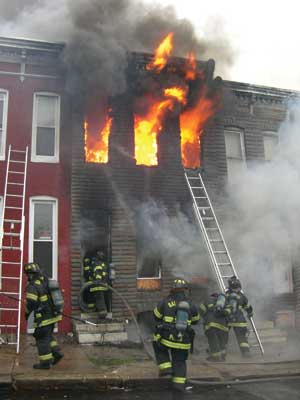 |
| (8) Firefighters reposition portable ladders to the upper floors of the main fire building immediately after the fire has been knocked down on the first floor. (Photo by Christopher Hutson.) |
Use the aerial ladder for roof operations when there is no life hazard present at an upper floor. This often provides the quickest access to the roof to begin vertical ventilation operations (photo 9). If the aerial ladder cannot be raised because of overhead obstructions, the structure is too far off the road, or the ground is of questionable stability, throw a ground ladder immediately to provide access to the roof. In some situations, it may be easier to use an adjoining building for roof access. Also place a roof ladder to the roof for overall safety even if the roof seems “walkable.”
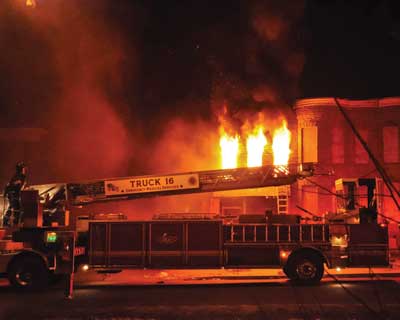 |
| (9) The aerial ladder is the quickest and safest way to get to the roof position. (Photo by Nick Eid.) |
Do not move the aerial ladder unless there is a safety issue or fire conditions will directly impinge on the ladder and until you have advised the roof firefighter that it is being moved. The firefighter assigned to the roof relies on that aerial as his main egress off the roof even though he should size up a secondary means of egress on making the roof.
VENTILATION
When the engine company is delayed, the impact on truck crews performing ventilation is great. Give significant thought as to where firefighters will ventilate the dwelling and when to initiate ventilation. This is particularly true for horizontal ventilation operations. These factors require smart decision making by truck crews and can make the difference between having effective interior operations and having to abandon interior firefighting efforts and force crews to retreat outside and wait for a charged hoseline.
Truck crews must delay horizontal ventilation-windows on the fire floor and the floor above-until a charged line has been stretched. “Venting for fire” and putting water on the fire must be a coordinated effort and cannot be done until the arrival of the engine company. It is not uncommon to have truck crews taking positions on ground ladders and delaying ventilation of upper-floor windows because they are waiting for a handline to be stretched to the front door of the dwelling (photos 10-12). Venting too early or aggressively can create autoexposure issues and increase the risk of drawing the fire toward trapped victims or firefighters operating on the interior.
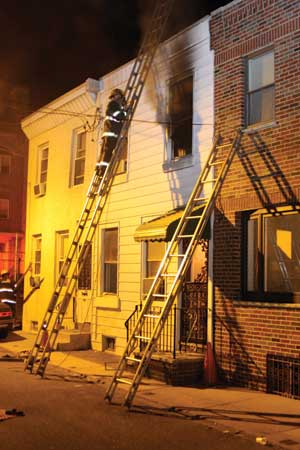 |
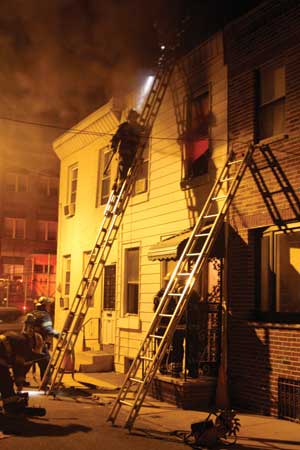 |
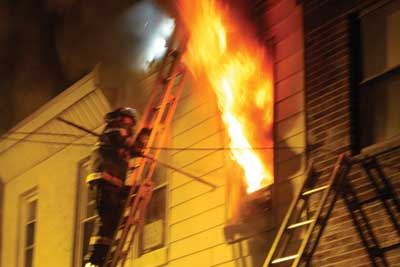 |
| (10-12) A firefighter positions himself on a portable ladder to initiate horizontal ventilation of the fire room. However, he delays ventilating until a charged hoseline has been stretched to the front door of the dwelling. Notice in photo 11 the firefighter prepares to vent as the engine company stretches a line to the front door and awaits the line to be charged. Once the engine company begins the push to the fire floor with a charged line, the vent firefighter takes the windows to the fire room. (Photos by Ron Trout.) |
The truck company, however, is not at a total loss. The tactic of “venting for life” or vent-enter-search (VES) enables truck crews to ventilate the dwelling in a controlled manner and to rescue a trapped victim (photo 13). The extent of the ventilation would consist of opening only the windows to the room to be searched. By doing this, the firefighter will be able to search more quickly, improving the chance of victim survival by removing the heat and smoke from the room.
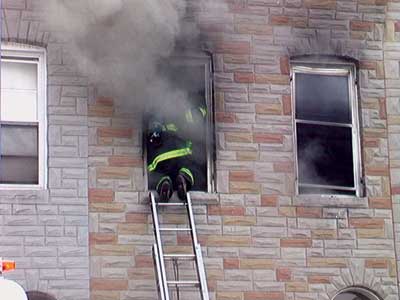 |
| (13) A firefighter performs vent-enter-search in the front bedroom of a two-story middle-of-the-group row home. It’s critical to read the smoke and heat conditions while making entry and to immediately attempt to close the door of the room. (Photo by author.) |
Vertical ventilation, however, must be a critical priority because ventilation holes/structural components in the roof will dramatically improve the smoke and heat conditions in the upper floors, resulting in increased visibility and the ability to locate victims more quickly. Prior to making the ventilation hole, the roof firefighter should communicate with the interior firefighters so that any change in fire or heat conditions can be monitored and reported. Recent studies in ventilation are showing the potential for creating a draft from the open front door and that pulling a bulkhead, a skylight, or a scuttle can cause a first-floor fire to ascend the stairs.
Skylights, scuttles, bulkheads, and other mechanical openings on the roof are the fastest ways to start the vertical ventilation process. These natural openings allow rapid ventilation and prevent mushrooming of the smoke, heat, and toxic gases inside the structure. Normally, these items are over a stairwell. Before completely removing their glass, issue a warning over the radio, or break one pane as a warning sign to members operating below. In some instances, a draft-stop is located below and must be ventilated also. Next, the firefighter should evaluate the need for cutting a ventilation hole in the roof. The ventilation hole should be made directly over the fire room and over an interior stairwell (which is normally located to one side of the structure) when the roof lacks any natural ventilation points. An example of this would be a row home with a flat roof that is entirely sealed and has had the scuttles or skylights removed from the roof.
VES
First-arriving truck crews should strongly consider VES, which should be conducted at all fires. VES is effective because it enables the truck company to conduct an immediate search of individual rooms on the fire floor or on the floor above the fire where it is suspected there may be a life hazard. The firefighter should begin by ventilating in a controlled manner (taking only one window) and then reading the smoke and heat conditions escaping from the opening because the escaping heat, smoke, and gases could light up when he enters the structure. Once inside, the firefighter should attempt to close the door to the room to prevent the window opening from drawing smoke, heat, gases, or fire to this location and then conduct a systematic search around the room. While searching, the firefighter must keep good orientation and maintain awareness of an egress route back to the window (photo 14). Closing the door to the room being searched will protect the firefighter from deteriorating fire conditions on that floor and may increase visibility in the room to assist in search operations.
 |
 |
| (14-15) Because of rapidly changing fire conditions, the firefighter is forced to abandon primary search efforts and egress from the second-floor front bedroom to a portable ladder. (Photos by Howard Meile III.) |
Place ground ladders for VES in the rescue position (with the tip at or just below the windowsill) so they don’t impede a firefighter’s access or egress into the window. Never move these ladders while firefighters are on the interior. Ground ladders are not just for victim removal; they are the primary ingress and egress routes for firefighters conducting VES operations (photo 15).
The impact of a delayed engine company on the fireground changes the dynamics of truck company operations. Firefighters will be challenged immediately in their decision making and actions to operate in an aggressive but safe manner. However, the basic principles of truck company operations do not change: Truck crews must still force entry, throw ladders, perform ventilation, and search properly to be effective and complete the mission (photo 16).
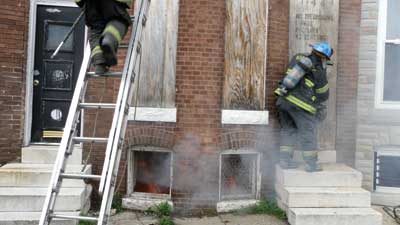 |
| (16) Firefighters do not delay in initiating the primary duties of the first-arriving truck company. (Photo by Nick Eid.) |
● JERRY SMITH JR. is a firefighter with the Baltimore City (MD) Fire Department, assigned to Rescue Company 1. He was previously assigned to Truck Company 15, which was disbanded in July 2012. He is a contributing author to Urban Firefighter Magazine and a tactical training instructor for Leadership Under Fire, Inc. He is also a public safety scuba instructor for Dive Rescue International and Baltimore City’s dive rescue team.
Jerry Smith Jr. will present “Truck Company Operations at Row Home Fires” on Thursday, April 25, 2013, 10:30 a.m.-12:15 p.m., at FDIC 2013 in Indianapolis.
Fire Engineering Archives

